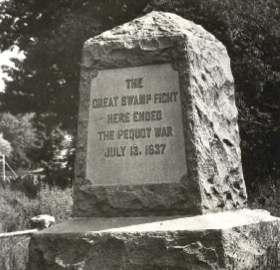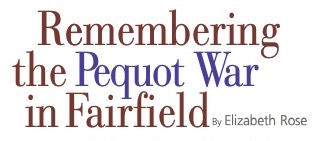(c) Connecticut Explored Inc. Winter 2014/2015
Subscribe/Buy the Issue!
The Pequot War of 1637, the culmination of a struggle for control of trade and territory between the English colonists and the powerful Pequot federation, was a pivotal moment in the development of Connecticut. It is also considered America’s first “total war” in that it included attacks on whole villages and aimed to eliminate the Pequot from the region. In Fairfield, where the final battle of the Pequot War took place, the conflict has taken a firm place in the town’s identity.
“By the 1630s,” Kevin McBride and Laurie Lamarre note in “Exploring and Uncovering the Pequot War” (Fall 2013), the Pequot, whose home territory was southeastern Connecticut, “exerted control across southern New England. … Pequot influence extended along coastal Long Island Sound from Fairfield, Connecticut to Charlestown, Rhode Island,” eastern Long Island and up the Connecticut River Valley to the Massachusetts border, including all of eastern Connecticut. They subjugated dozens of Native tribes and controlled the fur and wampum trade with the Dutch. The arrival of English traders in the Connecticut River Valley challenged this balance of power, leading to tensions that ultimately erupted into war.
The final battle of the Pequot War, known as the Swamp Fight, took place in Fairfield in July 1637, when English forces caught up with Pequot forces led by the sachem Sassacus, who had taken refuge near the village of their Sasqua allies. The Sasqua, along with the Unquowa and Pequonnock, were part of the Paugussett tribe that occupied much of western Connecticut. Like a number of Native groups along the coast, they owed allegiance to the Pequot.
The English and their Native allies, the Narragansett and Mohegans, surrounded the swamp, fighting hand to hand throughout the day and night as Pequot and their Sasqua allies, held them back. The next morning, under cover of fog, approximately 60 to 80 Pequot broke through a section of the English lines and escaped. About 180 Pequot were eventually captured, and a dozen or more were killed.
Sassacus and his warriors fled north from the swamp, hoping to find refuge with allies in eastern New York. But the Mohawks captured them in late July and quickly killed them, sending Sassacus’s head to the English as a gesture of friendship. Eventually the surviving Pequot sachems surrendered.

The Connecticut Society of Colonial Wars Pequot War monument, Fairfield, 1904. Fairfield Museum & History Center.
This monument now sits on a small piece of land between Old Post Road and Post Road in the Southport section of Fairfield
The Treaty of Hartford in 1638 intended to wipe out the once powerful Pequot nation, outlawing the Pequot name and language. Some of the captured Pequot were sent to live among Native allies of the English, while others were enslaved in the West Indies or in New England households. The largest group was placed under the control of the Mohegan, who treated them so harshly that by 1655 the English moved them to their own area, eventually creating the first reservations in Connecticut: Mashantucket in 1666 and Lantern Hill in 1683. It would take another 300 years for the Pequot to regain political and economic power in their traditional homeland.
For the English, victory meant that they could start establishing new settlements along the coast. Colonial leader Roger Ludlow brought a small group of colonists from Windsor in 1639 to establish a town amidst what he is said to have called the “fair fields,” farmed by local Indians close to where he had fought in this last major battle. Other veterans of the war would follow him, settling in Fairfield and neighboring towns along the coast.
Local lore related to the battle survived in Fairfield well into the 19th century. In 1869, author P.D. Ridge wrote in A Story of Pequot Swamp that children were frightened into obedience by mentioning that Indians might “still lurk in the dark recesses of this dreaded forest.” Farmers would regularly unearth arrowheads and other battle artifacts when plowing their fields, according to Ridge.
By the late 19th century, Native people had virtually disappeared from Fairfield, but the war found a lasting place as part of the town’s historic identity. The Pequot name—originally forbidden by the terms of the treaty—now conferred a special mystique to streets, sites, and organizations around Fairfield. The Pequot Library, Pequot School, and the Pequot Inn were the first to use the name, to be followed in the 20th century by the Pequot Yacht Club, the Pequot Motor Inn, the YMCA’s Pequot Indian Guides and the Pequot Running Club. Indeed, the name Pequot is used so frequently in town that many residents assume that the Pequot Indians lived in Fairfield; the names of the actual local Paugussett peoples (such as Unquowa and Sasqua) are not as well known.
At the turn of the 20th century, heritage organizations in Fairfield erected monuments to memorialize the Swamp Fight and “the valor and victory of the colonist forefathers” who fought there. Past celebrations of Fairfield’s history—from the tercentenary celebration in 1939 to school pageants—have highlighted the Pequot War as the beginning of the town’s history. A 1968 re-enactment of the battle took an irreverent approach to this violent history, including a “Surrender Site” and a “Bury the Hatchet” site in the celebration.
The Fairfield Museum is taking the occasion of Fairfield’s 375th anniversary to explore this aspect of our history in greater depth, collaborating with the Mashantucket Pequot Museum’s Battlefields of the Pequot War project to create the exhibition The Pequot War and the Founding of Fairfield. Featuring archaeological finds, 19th-century prints, items reflecting Pequot and early American material culture, and a 3-D model depicting the battle, the exhibition explores the timeline, causes and consequences of the war, for both the English and the Pequots, and looks at the ways in which the memory of the war has informed Fairfield’s identity over time.
The Pequot War and the Founding of Fairfield is on view from October 15, 2014 to January 18, 2015. The Fairfield Museum is open daily from 10 to 4. For more information visit fairfieldhistory.org.
Elizabeth Rose is library director at the Fairfield Museum and History Center and a member of the Connecticut Explorededitorial team.
Explore!
“Fairfield Celebrates its 375th” Summer 2014
“Connecticut’s Brand of Colonial Town,” Summer 2016
Read all of our stories about Native Americans in Connecticut on our TOPICS page
Read all of our stories about Connecticut at War on our TOPICS page

